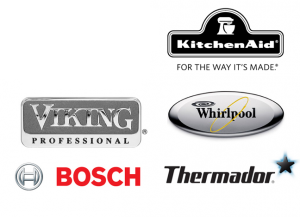The part(s) or condition(s) listed below for the symptom Refrigerator not cooling are ordered from most likely to least likely to occur. Check or test each item, starting with the items at the top of the page.
Most Frequent Causes for Refrigerator Ice Maker Not Working
| Cause 1 Freezer Temperature is Above 10 Degrees F (-12C) If the freezer temperature is above 10 degrees Fahrenheit (-12C), the ice maker will not produce ice cubes efficiently. The freezer temperature should be set between 0 and 5 degrees Fahrenheit (-18 to -15C) for the ice maker to work properly. If the freezer temperature is too high, ensure that the condenser coils are clear of debris and the condenser fan is working properly. In addition, check to see if frost has accumulated on the evaporator coils. If the evaporator coils are frosted over, part of the defrost system has likely failed. | Cause 2 Water Inlet Valve The water inlet valve is an electrically-controlled valve that opens to supply water to the dispenser and ice maker. If the water inlet valve is defective, or if it has insufficient pressure, it won’t allow water to flow through. As a result, the ice maker won’t make ice. The valve requires at least 20 psi to function properly. Make sure that the water pressure to the valve is at least 20 psi. If the water pressure is sufficient, use a multimeter to check for power to the water inlet valve. If the water inlet valve has sufficient pressure and is getting power, but the ice maker won’t fill with water to make ice, replace the water inlet valve. | Cause 3 Ice Maker Assembly One component of the ice maker assembly might be defective. Since many of the ice maker components are not sold separately, you may need to purchase and replace the entire ice maker assembly. Before replacing the ice maker assembly, check the water inlet valve, water line, and fan. If none of these parts are at fault, and the freezer temperature is at least 15 degrees Fahrenheit, replace the ice maker assembly. |
| Cause 4 Icemaker Module The icemaker module is equipped with a motor that cycles the ice ejector arms or turns a tray to eject the cubes into the ice bucket. When the thermostat or sensor on the icemaker tray reaches about 15 degrees Fahrenheit, the motor cycles to release the ice cubes. At the end of the cycle, the icemaker module sends power to the water inlet valve to refill the tray with water. If the icemaker module is defective, the ice maker won’t make or dispense ice. First, depending on your model, make sure that the on/off switch is in the on position or the bail arm is in the down position. If the icemaker module has ejector blades, check to ensure that ice cubes are not stuck in the blades. There are usually test points in the module that a technician can use to further diagnose problems with the module. | Cause 5 Low Water Pressure from House Supply The home may have insufficient water pressure. The water inlet valve supplies water to the ice and water dispenser. The water inlet valve requires a minimum of 20 psi to function properly. Check the water flow and test the pressure to determine if it is at least 20 psi. | Cause 6 Door Switch The door switch turns off the ice and water dispenser when the refrigerator door is open. If the door switch fails, the dispenser will not turn on. To determine if the door switch is defective, use a multimeter to test it for continuity. If the door switch does not have continuity when activated, replace it. |
| Cause 7 Ice Level Control Board Some refrigerators use an infrared beam to sense the level of ice in the ice bucket. When the ice level reaches the top of the bucket, it interrupts the infrared beam. The control board then shuts off the ice maker. When the ice level drops below the beam, the control board signals the ice maker to make more ice. If the ice level control board fails, the ice maker will stop making ice. Ensure that the ice level control board is getting power. If the ice level control board is getting power, but the ice maker won’t work, replace the ice level control board. | Cause 8 Water Filter A clogged water filter can restrict the flow of water to the dispenser and prevent the ice maker from working properly. The water filter should be replaced about every six months to maintain proper water flow and ensure water quality. | Cause 9 Icemaker Mold Thermostat The icemaker mold thermostat monitors the temperature of the ice mold (ice tray). Once the mold reaches the proper temperature, the icemaker ejects the ice cubes and refills the ice mold with water. If the mold thermostat is defective, the ice maker will stop making ice. To determine if the thermostat is defective, use a multimeter to test it for continuity. If the mold thermostat does not have continuity, replace it. (Note: If the ice maker is not cold enough, the mold thermostat contacts will open. If the thermostat contacts are open, the ice maker will not make ice. The ice maker temperature must generally be lower than 20 degrees Fahrenheit for the thermostat contacts to close.) |
| Cause 10 Icemaker Switch The ice maker switch might be defective. It is also possible that the icemaker switch got turned off by accident. Check the switch to ensure that it is turned on. If the icemaker switch is turned on, but the ice maker still isn’t working, use a multimeter to test the switch for continuity. If the icemaker switch does not have continuity, replace it. |
